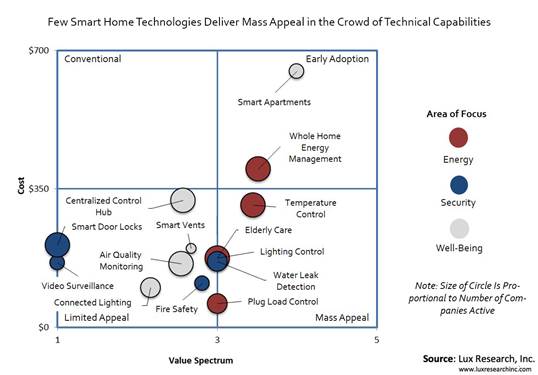Smart Home Tech Has Drawn $550 Million in Funding, but Costs Limit Adoption
Smart homes have come a long way since emerging as a simple home energy management tool and now offer enhanced capabilities ranging from security to air quality monitoring and elderly care, but remain hobbled by high costs – $6,700 for a fully enabled home, according to Lux Research.
 The industry attracted $550 million in venture investment from 2005 to 2014, with funding spiking in 2012. A wave of sizeable exits has followed – Google’s acquisition of Nest and Dropcam, Samsung’s buy of SmartThings, and Flextronics’ acquisition of Wink.
The industry attracted $550 million in venture investment from 2005 to 2014, with funding spiking in 2012. A wave of sizeable exits has followed – Google’s acquisition of Nest and Dropcam, Samsung’s buy of SmartThings, and Flextronics’ acquisition of Wink.
“Over the past 36 months, we have seen a dramatic shift in the number and capabilities of smart home devices but hardware cost reductions have not kept pace with this scale-up,” said Alex Herceg, Lux Research Analyst and the lead author of the report titled, “Smart Homes: Chasing the Elusive Dream.”
“In many applications, benefits are increasingly complex to quantify, making it a challenge to communicate the value proposition to consumers,” he added.
Lux Research analysts evaluated the evolution of smart homes, quantifying costs and benefits for varied technologies and applications. Among their findings:
• Wink emerging as leading platform. Smart home platforms are still in early stages, and are working to add capabilities and partners. Wink has the most company partners overall (16) with many large companies, while Nest has the most start-up partners (18), as well as more capabilities than any of its peers.
• Temperature control still the only “killer app”. Companies offering smart thermostats form the most crowded smart home segment, offering energy savings between 12% and 30%, at a cost of $250 to $400. Whole home energy management costs more and offers only incremental gains.
• Smart apartments near mass adoption. Smart apartments are a relative blue ocean. While costs are high at up to $900/unit, a strong service-delivery model helps amortize high hardware costs, pushing toward mass adoption. This model has the potential to be replicated for connected homes.
The report, titled “Smart Homes: Chasing the Elusive Dream,” is part of the Lux Research Intelligent Buildings Intelligence service.

Comments are closed, but trackbacks and pingbacks are open.